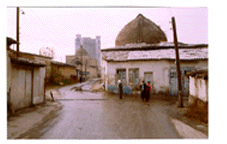 Tashkent
Tashkent
prepared by
Iraj Bashiri
copyright 1998
Situated on the foothills of the western Tien Shan, in the Chirchik River Valley, Tashkent, the capital of the present-day republic of Uzbekistan, has a long and glorious history. Called Chach, Chachkent, and Binkent in the first millennium BC., it thrived as a major link between Europe and the Far East on the Silk Road. In later times, especially after the Arab invasion (8th century AD), it became a major Islamic stronghold against Turkish invaders of Transoxania. The name "Tashkent" is met for the first time in historical sources in the 11th century. In the 13th century Tashkent was conquered by the Mongols and, later on, by the Timurids. The last native rulers of Tashkent were the Khans of Kokand who ruled the region until 1865.
Russians invaded and occupied Tashkent in 1865. At the time, the city served as a Russian springboard for the further conquest of the Kuhistan. In 1867, Tashkent became the administrative center of the new governor-general of Turkistan; it also served as Europe's port of entry into Central Asia. Trade on the Silk Road continued to add to its prosperity as did involvement in the administrative activities of the Russians in their newly annexed regions. In fact, a new city grew up beside old Tashkent, housing the many officials who dealt with the ever-increasing affairs of Russia in Central Asia.
During the Soviet Era, Tashkent temporarily lost its status as capital to the city of Samarqand (1924-1930). Establishment of Samarqand as the capital, however, was a political move. In 1930, Tashkent became the capital of the newly formed Republic of Uzbekistan and, in subsequent decades, became the fourth largest capital of the former Soviet Union, after Moscow, Leningrad, and Kiev.

Today, Tashkent is a major industrial and cultural center not only for Uzbekistan but for the whole of Central Asia. Its factories produce excavators and cranes as well as textile, appliances, and household goods. In addition, as the educational, administrative, and cultural center of Uzbekistan, it also holds the largest libraries, the best equipped laboratories, and the most valuable fund of manuscripts and documents of Central Asia in its archives. The Navoi Library, for instance, is reported to hold over 8 million books.
Former Soviet cities are known for their administrative and cultural centers. Tashkent is no exception. The Uzbek Economic Achievement Exhibition displays cotton picking and cotton processing, a task to which every Uzbek has, willingly or otherwise, contributed. Similarly, the Museum of Uzbek Art houses many of the traditional treasures of Central Asia, mostly the ones that did not make it to Moscow. There are also contributions from Europe, India, China, and Japan on display.
In 1966, Tashkent was shaken by a massive earthquake that made 300,000 of its inhabitants homeless. Aided by Soviets from other republics of the former Soviet Union, the inhabitants of Tashkent rebuilt their city, adding a beautiful modern metro in the process. In fact, Tashkent is the only city in Central Asia with a subway system. The Uzbeks renamed the city's new streets and districts after the republics, or the greats of the republics, that had come to their assistance.

Uzbeks use both Uzbeki and Russian as the medium of conversation. A good number of them also have a workable understanding of Tajiki. In general, the Uzbeks are Sunni Muslims of the Hanafi sect. Today, they are refurbishing their mosques and madrasahs not only in Tashkent but in Samarqand and Bukhara as well.
As mentioned, since early Islamic times, Tashkent has served as a major force in the promotion of Islam in Transoxania and its environs. During the Soviet Era, for instance, it was one of the four centers of Islam in Soviet domains. Indeed, as the headquarters of the Muslim Board of Central Asia and Kazakhstan, it played a major role in the lives of Muslim Central Asians, in general, and of Uzbeks in particular.
The most attractive and memorable part of Tashkent is its bazaar or, more precisely, where the bazaar is located. Almost on the line that separates the old quarters from the new, the visitor finds himself or herself surrounded by the results of centuries of interaction among peoples struggling to forge ahead. The old part of the city happens to be on the side of a hill, overseeing the new. Standing by the broken walls of mosques and madrasahs, one can view how skyscrapers, like the modern Uzbekistan Hotel, dwarf the Islamic buildings, even the ones on the hill.
Top of the page
Bishkek
Dushanbe
Almaty
Ashgabat
Home | Tajikistan Update


